Family name: Malvaceae Jussieu
Synonym(s): Bombacaceae Kunth, nom. cons.; Brownlowiaceae Cheek; Byttneriaceae R. Br., nom. cons.; Dombeyaceae Kunth; Durionaceae Cheek; Fremontiaceae J. Agardh, nom. illeg.; Helicteraceae J. Agardh; Hermanniaceae Marquis; Hibiscaceae J. Agardh; Lasiopetalaceae Rchb.; Melochiaceae J. Agardh; Pentapetaceae Bercht. & J. Presl; Philippodendraceae A. Juss.; Plagianthaceae J. Agardh; Sparmanniaceae J. Agardh; Sterculiaceae Vent., nom. cons.; Theobromataceae J. Agardh; Tiliaceae Juss., nom. cons.; Triplochitonaceae K. Schum., nom. nud.
Common name(s): mallow family
*Number of genera/species: 251/4,225
List of genera records in GRIN-Global
Fruit often a loculicidal capsulecapsule:
a dry, dehiscent fruit derived from a compound ovary , sometimes a folliclefollicle:
, sometimes a folliclefollicle:
a dry to (rarely) fleshy fruit derived from a single carpel that opens along a single longitudinal suture, derived from a single, superior, simple ovary; the seeds may be arillate or with a fleshy testa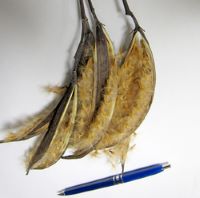 , or sometimes an indehiscentindehiscent:
, or sometimes an indehiscentindehiscent:
not opening on its own, as in a fruit
 pod, rarely a drupedrupe:
pod, rarely a drupedrupe:
(indehiscent drupe) a fleshy, indehiscent fruit with one more hard pits enclosing seeds, derived from single, superior, simple or compound ovary; (dehiscent drupe) a fruit with a dry or fibrous to fleshy or leathery outer husk that early to tardily breaks apart (or opens), exposing one or more nutlike pits enclosing the seeds (fleshy or dry) with 1 or more pyrenespyrene:
(fleshy or dry) with 1 or more pyrenespyrene:
the hard inner portion of a drupe, consisting of a bony endocarp and an enclosed seed
, or schizocarpschizocarp:
usually dry fruit splitting between two or more locules to form distinct, indehiscent, usually one seeded segments; fruit derived from a single, superior or inferior, compound ovary; compare to mericarp splitting into 1- or few-seeded indehiscentindehiscent:
splitting into 1- or few-seeded indehiscentindehiscent:
not opening on its own, as in a fruit
 (achene-like or samara-like) or dehiscentdehiscent:
(achene-like or samara-like) or dehiscentdehiscent:
(v. dehisce) splitting open at maturity to release contents (of a fruit) mericarps, 1–300 mm long, globoseglobose:
mericarps, 1–300 mm long, globoseglobose:
3D shape—more or less spherical to angularangular:
to angularangular:
2D shape—having sides that meet at acute or obtuse angles
, mericarpsmericarp:
a one-seeded section (carpel) of a schizocarp, as in Apiaceae fruits (compare schizocarp)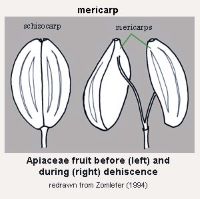 usually reniformreniform:
usually reniformreniform:
2D or 3D shape—kidney-shaped or oblongoblong:
or oblongoblong:
2D shape—much longer than broad with nearly parallel sides, corners are rounded , usually tereteterete:
, usually tereteterete:
approximately circular in cross section; width and thickness approximately equal
 or triangulartriangular:
or triangulartriangular:
2D shape—three relatively straight sides with distinct corners; more angular than teardrop-shaped (Malva) or starlike (Allowissadula) in transection, sometimes short beakedbeak:
(Malva) or starlike (Allowissadula) in transection, sometimes short beakedbeak:
a usually firm, terminal appendage, sometimes tapered , rarely winged, if present one laterallateral:
, rarely winged, if present one laterallateral:
(of embryo) embryo lies along the side of the seed, generally towards one end; of, at, or from the side; in grasses, can refer to the sides adjacent to the dorsal and ventral sides
wing (some Sterculioideae spp.), with one to many seeds, rarely subtended by persistent, accrescentaccrescent:
growing continuously
calyx. Pericarppericarp:
fruit wall or fruit coat
brown, black, gray, purple, green, pink, red, orange, yellow, or white, shinyshiny:
uniformly reflecting a high proportion of incident light at all angles or dulldull:
or dulldull:
reflecting only a low proportion of incident light, with no apparent sheen , usually woodywoody:
, usually woodywoody:
texture—consisting mainly of indurate lignified tissues, characteristic of or resembling wood
, fleshy, membranousmembranous:
texture—extremely thin, pliable, and fairly tough
, rarely crustaceous-papery (Pityranthe) or spongyspongy:
soft, light, discontinuous but cohesive, and somewhat resilient
(some Heritiera spp.), glabrousglabrous:
without hairs
or sometimes pubescentpubescent:
surface relief—bearing hairs
, if pubescentpubescent:
surface relief—bearing hairs
, hairs simple or star-shapedstar-shaped:
(of fruit), having a distal aspect like the stylized shape of a star, usually found in aggregate versus simple fruit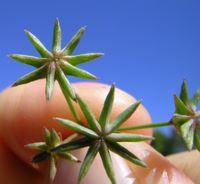 , often appearing twisted and matted. Pericarppericarp:
, often appearing twisted and matted. Pericarppericarp:
fruit wall or fruit coat
smooth, sometimes ribbedribbed:
surface relief—wide, prominent, linear ridges that are generally rounded and longitudinally situated on the surface , ridgedridged:
, ridgedridged:
surface relief—raised, thick ridges, sharp edged or rounded, usually in a series that may cover the entire surface , or wartywarty:
, or wartywarty:
surface relief—distinct, rounded projections that are large relative to the fruit size; tuberculate, verrucose , or with bristles or spines, rarely lobed or veinedveined:
, or with bristles or spines, rarely lobed or veinedveined:
surface relief—lines that intersect in a vein pattern that is flush or slightly raised from the surface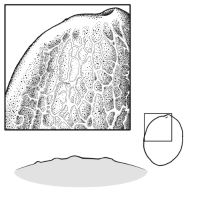 . Mesocarpmesocarp:
. Mesocarpmesocarp:
the middle layer of the pericarp, if divided into layers , if present, woodywoody:
, if present, woodywoody:
texture—consisting mainly of indurate lignified tissues, characteristic of or resembling wood
, bonybony:
very hard and rather brittle, like bone
, leatheryleathery:
texture—moderately thick, tough, and very pliable
, fibrousfibrous:
texture -- long, flexible threads, thicker than hairs, that densely cover and obscure the surface , or fleshy. Endocarpendocarp:
, or fleshy. Endocarpendocarp:
the inner layer of the pericarp, if divided into layers , if present, thin, bonybony:
, if present, thin, bonybony:
very hard and rather brittle, like bone
or woodywoody:
texture—consisting mainly of indurate lignified tissues, characteristic of or resembling wood
, or pulpy and often pubescentpubescent:
surface relief—bearing hairs
in capsulescapsule:
a dry, dehiscent fruit derived from a compound ovary (Bombacoideae, Dombeyoideae ). Note hairs on or in fruits and on seeds may be star-shapedstar-shaped:
(Bombacoideae, Dombeyoideae ). Note hairs on or in fruits and on seeds may be star-shapedstar-shaped:
(of fruit), having a distal aspect like the stylized shape of a star, usually found in aggregate versus simple fruit .
.
Seeds often reniformreniform:
2D or 3D shape—kidney-shaped , trigonoustrigonous:
, trigonoustrigonous:
3D shape—having three faces that meet at distinct angles; triangular in outline
, or turbinateturbinate:
3D shape—broadly obovoid-obconic
, sometimes with fold between cotyledons and hypocotyl-radicle or notched, sometimes raphaeraphe:
a ridge or seam on the seed coat, formed by the portion of the funiculus united to the ovule wall in longitudinally curved ovules conspicuous. Seeds compressedcompressed:
conspicuous. Seeds compressedcompressed:
flattened; in grasses, used to denote compression (not necessarily flattened) either laterally or dorsiventrally
, tereteterete:
approximately circular in cross section; width and thickness approximately equal
 , or triangulartriangular:
, or triangulartriangular:
2D shape—three relatively straight sides with distinct corners; more angular than teardrop-shaped (Sterculioideae) in transection, 1–50 mm long. Rarely winged (Bernoullia, Pterygota). ArilsAril:
(Sterculioideae) in transection, 1–50 mm long. Rarely winged (Bernoullia, Pterygota). ArilsAril:
(broad sense) appendicular structure that wholly or partly envelops a seed and is produced from or a modification of the funicle, raphe, or outer integument; usually fleshy or pulpy, sometimes spongy or tufted-capillate, often brightly colored or carunclescaruncle:
or carunclescaruncle:
a localized outgrowth of the seed coat near the hilum of the seed; it functions as an elaiosome sometimes present (Abroma, Commersonia, Coelostegia, Cullenia, Durio, Mortoniodendron, Neesia), if present, brown, red, orange, yellow, or white, adnate to hila or seed coats, usually fleshy, basalbasal:
sometimes present (Abroma, Commersonia, Coelostegia, Cullenia, Durio, Mortoniodendron, Neesia), if present, brown, red, orange, yellow, or white, adnate to hila or seed coats, usually fleshy, basalbasal:
at or pertaining to the point of attachment; (of embryo) embryo occupies one end of the seed
or encompassing seeds, fimbriate, cushion-like, or entire. Seed coat brown, black, black to blue with white hilumhilum:
on seeds, the scar indicating where the funiculus was attached; on grass caryopses, the scar visible on the outer fruit surface revealing where the seed is attached on the inner fruit wall surface; or in Asteraceae cypselae, the scar visible on the outer fruit wall revealing where the fruit was attached to the receptacle (Sterculia), purple, gray, red, orange, or whitish, shinyshiny:
(Sterculia), purple, gray, red, orange, or whitish, shinyshiny:
uniformly reflecting a high proportion of incident light at all angles or dulldull:
or dulldull:
reflecting only a low proportion of incident light, with no apparent sheen , usually glabrousglabrous:
, usually glabrousglabrous:
without hairs
, if pubescentpubescent:
surface relief—bearing hairs
, hairs short to long, straight or curly, and sometimes densely covering seed coat, smooth or reticulatereticulate:
surface relief—netted, raised walls or concave grooves forming a net-like surface pattern with flat, concave, or convex interspaces , papillatepapillate:
, papillatepapillate:
surface relief—bearing minute, distinct, broad-based projections, tapering to a rounded apex , striatestriate:
, striatestriate:
surface relief—having fine, parallel lines, grooves or ridges , granulargranular:
, granulargranular:
surface relief—having a grainy surface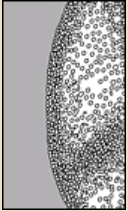 , wrinkledwrinkled:
, wrinkledwrinkled:
surface relief—shallow, irregular folds and furrows covering the surface; appearing overall though crumpled and then spread out , or wartywarty:
, or wartywarty:
surface relief—distinct, rounded projections that are large relative to the fruit size; tuberculate, verrucose . Fleshy sarcotestasarcotesta:
. Fleshy sarcotestasarcotesta:
pulpy or fleshy outer layer of the seed coat, simulates aril present in some Sterculioideae. HilaHilum:
present in some Sterculioideae. HilaHilum:
on seeds, the scar indicating where the funiculus was attached; on grass caryopses, the scar visible on the outer fruit surface revealing where the seed is attached on the inner fruit wall surface; or in Asteraceae cypselae, the scar visible on the outer fruit wall revealing where the fruit was attached to the receptacle often larger than punctatepunctate:
often larger than punctatepunctate:
surface relief—dotted with pits or with translucent, sunken glands or with colored dots, similar to pitted .
.
Embryo well developed, completely to nearly filling seed coat, axileaxile:
on or of the axis
and centric, foliatefoliate:
appearing leaf-like
, straight, bentbent:
(of embryo) embryo is bent at an acute, V-shaped angle with the ends close together and generally thick cotyledons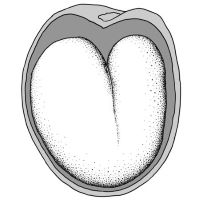 , arcuate, or J-shaped, with investinginvesting:
, arcuate, or J-shaped, with investinginvesting:
(of embryo) embryo is nearly or completely filling seed coat, straight, and axile and centric with spatulate cotyledons and covering the stalk for at least half its length; (of cotyledons) cotyledons spatulate and covering the stalk for at least half its length
or spatulatespatulate:
2D shape—like a spatula; rounded at the apex, with base long and tapered; (of embryo) embryo is straight and axile and centric with the cotyledons expanded to form the shape of a spatula or spoon; (of cotyledons) cotyledons expanded and wider than the stalk but not invested into the stalk cotyledons. Cotyledons thin or fleshy, straight and flat, or often folded, wrinkledwrinkled:
cotyledons. Cotyledons thin or fleshy, straight and flat, or often folded, wrinkledwrinkled:
surface relief—shallow, irregular folds and furrows covering the surface; appearing overall though crumpled and then spread out , or contorted , as wide as or 8x wider than hypocotyl-radicle.
, or contorted , as wide as or 8x wider than hypocotyl-radicle.
Endosperm copious, reduced, or absent. If present, smooth, hard, fleshy, or mucilaginousmucilaginous:
resembling mucilage; moist and sticky
.
Can be a weed in uplands, wetlands, grasslands, and forests. It often forms dense clumps or establishes predominant populations and spreads by seed reproduction. Abutilon theophrasti is considered a damaging weed to agricultural crops, especially corn and soybeans in many areas in the world. Melochia corchorifolia is observed to be a host of fungal diseases, such as Rhizoctonia solani.
Malvella leprosa is considered a noxious weed in Arizona. Abutilon theophrasti is a noxious weed in Colorado, Iowa, Michigan, North Carolina, Rhode Island, Vermont, and Washington. Anoda cristata is a noxious weed in Colorado, Delaware, Maryland, New Jersey, and North Carolina. Urena lobata and Malachra alceifolia are noxious weeds in Hawaii. Hibiscus trionum is a noxious weed in Colorado and Wyoming.
Fruits of several species are imported as dried botanical material for more information, see the Dried Botanical Identification tool. Aquarium & Pond Plants of the World tool includes descriptions and images of Hibiscus species, which may be encountered.
| Fruit | |
| Type | loculicidalloculicidal: type of capsular dehiscence, opening longitudinally through the locules (compare septicidal)  capsulecapsule: capsulecapsule:a dry, dehiscent fruit derived from a compound ovary  , folliclefollicle: , folliclefollicle:a dry to (rarely) fleshy fruit derived from a single carpel that opens along a single longitudinal suture, derived from a single, superior, simple ovary; the seeds may be arillate or with a fleshy testa  , indehiscentindehiscent: , indehiscentindehiscent:not opening on its own, as in a fruit  pod, drupedrupe: pod, drupedrupe:(indehiscent drupe) a fleshy, indehiscent fruit with one more hard pits enclosing seeds, derived from single, superior, simple or compound ovary; (dehiscent drupe) a fruit with a dry or fibrous to fleshy or leathery outer husk that early to tardily breaks apart (or opens), exposing one or more nutlike pits enclosing the seeds  , or schizocarp , or schizocarp |
| Size range | 1–300 mm long |
| Shape(s) | globoseglobose: 3D shape—more or less spherical  , lens-shapedlens-shaped: , lens-shapedlens-shaped:2D shape—round and flattened with two curved (convex) surfaces , ellipsoidellipsoid: 3D shape—elliptic , fusiformfusiform: spindle-shaped; broadest at the middle and tapering at both ends  , oblongoblong: , oblongoblong:2D shape—much longer than broad with nearly parallel sides, corners are rounded  , cylindricalcylindrical: , cylindricalcylindrical:3D shape—a cylinder, with parallel sides and a circular cross-section; tubular or rod-shaped , wedge-shapedwedge-shaped: 2D shape—triangular and tapering to a point at the base 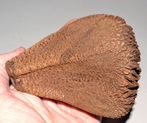 , ovoidovoid: , ovoidovoid:3D shape—ovate  , conicalconical: , conicalconical:3D shape—cone-shaped, with the point of attachment at the broad end 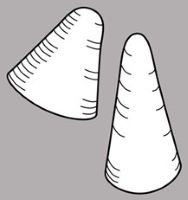 , or angularangular: , or angularangular:2D shape—having sides that meet at acute or obtuse angles , mericarpsmericarp: a one-seeded section (carpel) of a schizocarp, as in Apiaceae fruits (compare schizocarp)  usually reniformreniform: usually reniformreniform:2D or 3D shape—kidney-shaped  or oblongoblong: or oblongoblong:2D shape—much longer than broad with nearly parallel sides, corners are rounded  |
| Texture | woodywoody: texture—consisting mainly of indurate lignified tissues, characteristic of or resembling wood , fleshy, membranousmembranous: texture—extremely thin, pliable, and fairly tough , rarely crustaceous-papery, spongyspongy: soft, light, discontinuous but cohesive, and somewhat resilient |
| Surface relief | smooth, sometimes ribbedribbed: surface relief—wide, prominent, linear ridges that are generally rounded and longitudinally situated on the surface  , ridgedridged: , ridgedridged:surface relief—raised, thick ridges, sharp edged or rounded, usually in a series that may cover the entire surface  , or wartywarty: , or wartywarty:surface relief—distinct, rounded projections that are large relative to the fruit size; tuberculate, verrucose  , or with bristles or spines, rarely lobed or veinedveined: , or with bristles or spines, rarely lobed or veinedveined:surface relief—lines that intersect in a vein pattern that is flush or slightly raised from the surface  |
| Color(s) | brown, black, gray, purple, green, pink, red, orange, yellow, white |
| Unique features | Fruits are highly variable in type, size, and shape. Mericarps are often distinctly curvedcurved: (of embryo) linear embryo is curved into an arch or horseshoe with the ends far apart  and flattened with sculptured surface. and flattened with sculptured surface. |
| Seed | |
| Size range | 1–50 mm long |
| Shape(s) | often reniformreniform: 2D or 3D shape—kidney-shaped  , trigonoustrigonous: , trigonoustrigonous:3D shape—having three faces that meet at distinct angles; triangular in outline , or turbinateturbinate: 3D shape—broadly obovoid-obconic , also sectoroidsectoroid: 3D shape—a wedge-shaped slice taken from an ovoid or globose structure (2D shape, sector-shaped) 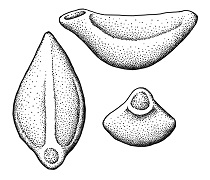 , globoseglobose: , globoseglobose:3D shape—more or less spherical  , ellipsoidellipsoid: , ellipsoidellipsoid:3D shape—elliptic , lens-shapedlens-shaped: 2D shape—round and flattened with two curved (convex) surfaces , wedge-shapedwedge-shaped: 2D shape—triangular and tapering to a point at the base  |
| Surface relief | smooth, reticulatereticulate: surface relief—netted, raised walls or concave grooves forming a net-like surface pattern with flat, concave, or convex interspaces  , papillatepapillate: , papillatepapillate:surface relief—bearing minute, distinct, broad-based projections, tapering to a rounded apex  , granulargranular: , granulargranular:surface relief—having a grainy surface  , striatestriate: , striatestriate:surface relief—having fine, parallel lines, grooves or ridges  , wrinkledwrinkled: , wrinkledwrinkled:surface relief—shallow, irregular folds and furrows covering the surface; appearing overall though crumpled and then spread out  , wartywarty: , wartywarty:surface relief—distinct, rounded projections that are large relative to the fruit size; tuberculate, verrucose  |
| Color(s) | brown, black, black to blue with white hilumhilum: on seeds, the scar indicating where the funiculus was attached; on grass caryopses, the scar visible on the outer fruit surface revealing where the seed is attached on the inner fruit wall surface; or in Asteraceae cypselae, the scar visible on the outer fruit wall revealing where the fruit was attached to the receptacle  (Sterculia), purple, gray, red, orange, whitish (Sterculia), purple, gray, red, orange, whitish |
| Unique features | Usually strongly reniformreniform: 2D or 3D shape—kidney-shaped  or globoseglobose: or globoseglobose:3D shape—more or less spherical  seeds with folded or crumpled cotyledons. HilaHilum: seeds with folded or crumpled cotyledons. HilaHilum:on seeds, the scar indicating where the funiculus was attached; on grass caryopses, the scar visible on the outer fruit surface revealing where the seed is attached on the inner fruit wall surface; or in Asteraceae cypselae, the scar visible on the outer fruit wall revealing where the fruit was attached to the receptacle  in globoseglobose: in globoseglobose:3D shape—more or less spherical  (or plump ellipsoidellipsoid: (or plump ellipsoidellipsoid:3D shape—elliptic ) seeds terminal. HilaHilum: on seeds, the scar indicating where the funiculus was attached; on grass caryopses, the scar visible on the outer fruit surface revealing where the seed is attached on the inner fruit wall surface; or in Asteraceae cypselae, the scar visible on the outer fruit wall revealing where the fruit was attached to the receptacle  in reniformreniform: in reniformreniform:2D or 3D shape—kidney-shaped  seeds within notch, split partially or completely down the middle, and frequently covered with a rough substrate that easily cracks off. Reniformreniform: seeds within notch, split partially or completely down the middle, and frequently covered with a rough substrate that easily cracks off. Reniformreniform:2D or 3D shape—kidney-shaped  seeds also frequently with a parallel pattern of small scales or protuberances or straight or star-like hairs. Seeds sometimes embedded in pulp or densely hairy endocarpendocarp: seeds also frequently with a parallel pattern of small scales or protuberances or straight or star-like hairs. Seeds sometimes embedded in pulp or densely hairy endocarpendocarp:the inner layer of the pericarp, if divided into layers  or with arilsaril: or with arilsaril:(broad sense) appendicular structure that wholly or partly envelops a seed and is produced from or a modification of the funicle, raphe, or outer integument; usually fleshy or pulpy, sometimes spongy or tufted-capillate, often brightly colored  . . |
| Other | |
| Embryo | well developed, completely to nearly filling seed coat, axileaxile: on or of the axis and centric, foliatefoliate: appearing leaf-like , straight, bentbent: (of embryo) embryo is bent at an acute, V-shaped angle with the ends close together and generally thick cotyledons  , arcuate, or J-shaped, with investinginvesting: , arcuate, or J-shaped, with investinginvesting:(of embryo) embryo is nearly or completely filling seed coat, straight, and axile and centric with spatulate cotyledons and covering the stalk for at least half its length; (of cotyledons) cotyledons spatulate and covering the stalk for at least half its length or spatulatespatulate: 2D shape—like a spatula; rounded at the apex, with base long and tapered; (of embryo) embryo is straight and axile and centric with the cotyledons expanded to form the shape of a spatula or spoon; (of cotyledons) cotyledons expanded and wider than the stalk but not invested into the stalk  cotyledons. Cotyledons thin or fleshy, straight and flat, or often folded, wrinkledwrinkled: cotyledons. Cotyledons thin or fleshy, straight and flat, or often folded, wrinkledwrinkled:surface relief—shallow, irregular folds and furrows covering the surface; appearing overall though crumpled and then spread out  , or contorted, as wide as or 8x wider than hypocotyl-radicle. , or contorted, as wide as or 8x wider than hypocotyl-radicle. |
| Nutritive tissue | endosperm copious, reduced, or absent. If present, smooth, hard, fleshy, or mucilaginousmucilaginous: resembling mucilage; moist and sticky |
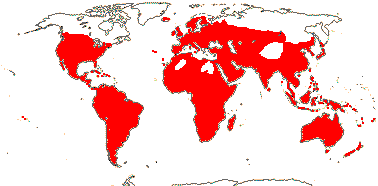
Distribution map courtesy of Angiosperm Phylogeny Website.
Bingham et al. 2021+Bingham et al. 2021+:
Bingham MG, Willeman A, Wursten BT, Ballings P, and Hyde MA. 2021. Flora of Zambia. Accessed January 2021–April 2024. URL: https://www.zambiaflora.com; Flora of Australia 2021+Flora of Australia 2021+:
Flora of Australia. Australian Biological Resources Study, Canberra. Accessed January 2021–March 2024. URL: http://www.ausflora.org.au; Flora of North America Editorial Committee 1993+Flora of North America Editorial Committee 1993+:
Flora of North America Editorial Committee, eds. 1993+. Flora of North America North of Mexico [Online]. 22+ vols. Flora of North America Association, New York and Oxford. Accessed January-March 2024. URL: http://beta.floranorthamerica.org.; Hyde et al. 2021b+Hyde et al. 2021b+:
Hyde MA, Wursten BT, Ballings P, and Coates Palgrave M. 2021b. Flora of Mozambique. Accessed January 2021–April 2024. URL: https://www.mozambiqueflora.com/index.php; Kirkbride et al. 2006Kirkbride et al. 2006:
Kirkbride JH, Jr, Gunn CR, and Dallwitz MJ. 2006. Family guide for fruits and seeds, vers. 1.0. Accessed September 2020-January 2022. URL: https://nt.ars-grin.gov/seedsfruits/keys/frsdfam/index.cfm .; Koekemoer et al. 2023Koekemoer et al. 2023:
Koekemoer M, Steyn HM, and Bester SP. 2023. Guide to plant families of southern Africa Lucid Key. South African National Biodiversity Institute. Accessed March 2023.; Kubitzki et al. 1990+Kubitzki et al. 1990+:
Kubitzki K et al., eds. 1990+. The families and genera of vascular plants. 7+ vols. Berlin etc.; Takhtajan 2009Takhtajan 2009:
Takhtajan A. 2009. Flowering plants: Second edition. Springer Nature, Switzerland. 871 pp.; Tropicos.org 2021+Tropicos.org 2021+:
Tropicos.org. 2021+. Pakistan Plant Database. Missouri Botanical Garden. Accessed January 2021–April 2024. http://legacy.tropicos.org/Project/Pakistan; USDA 1980USDA 1980:
United States Dept. of Agriculture (USDA). 1980. Major weed family identification guide. Hyattsville Md, United States ; Zhengyi et al. 2004+Zhengyi et al. 2004+:
Zhengyi W, Raven PH, and Deyuan H. 2004+. Flora of China [online]. 25 vols. Science Press, Beijing China & Missouri Botanical Garden, St. Louis USA. Accessed January–March 2024. http://flora.huh.harvard.edu/china/
*The number of genera and species is based on Christenhusz and Byng 2016Christenhusz and Byng 2016:
Christenhusz MJM and Byng JW. 2016. The number of known plant species in the world and its annual increase. Phytotaxa 261 (3): 201-217. https://doi.org/10.11646/phytotaxa.261.3.1, which may differ from the number of genera in GRIN-Global.
|
Fruit, seeds: Brachychiton populneus, fruiting pedicel, detached; interior view of follicle containing seeds; interior view of follicle without seeds; detached cluster of seeds, most with yellow exotestae intact, and encased in stellate-hirsute inner pericarp; seeds (grey-white) with exotestae removed; Photo by M. Maher, USDA APHIS PPQ ITP, imageID.idtools.org
|
|